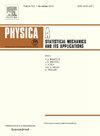Cellular automata-based long platoon models based on dynamic multi-virtual leading vehicles
IF 2.8
3区 物理与天体物理
Q2 PHYSICS, MULTIDISCIPLINARY
Physica A: Statistical Mechanics and its Applications
Pub Date : 2025-02-12
DOI:10.1016/j.physa.2025.130438
引用次数: 0
Abstract
With the development of Connected Vehicles technology and Cooperative Vehicle Infrastructure System, the “long” platoon has become a promising trend of platooning technology, and long platoons can take the full advantages of platoons in enhancing traffic efficiency and reducing energy consumption. In this paper, we propose a Cellular Automata-based long platoon model in which the platoon is divided into several sub-platoons and virtual leading vehicles are assigned to the sub-platoons dynamically according to the surrounding traffic states. Moreover, to evaluate the proposed model, it is compared with the Lenarska’s model and the traditional Cooperative Adaptive Cruise Control (CACC) model by simulations, and the influences of the long platoon size and traffic perturbations on the platoon are analyzed. The simulations indicate that for the acceleration and deceleration perturbation scenarios, the virtual leaders effectively divide the long platoon into multiple sub-platoons, and its sequence can change dynamically to reduce the influence of the perturbation on the platoon. Compared to the Lenarska’s model and the CACC model, the proposed model reacts to the speed perturbations faster and has smaller speed variations. The proposed model has better stability and safety and is more efficient than the Lenarska’s model and the CACC model.
求助全文
约1分钟内获得全文
求助全文
来源期刊
CiteScore
7.20
自引率
9.10%
发文量
852
审稿时长
6.6 months
期刊介绍:
Physica A: Statistical Mechanics and its Applications
Recognized by the European Physical Society
Physica A publishes research in the field of statistical mechanics and its applications.
Statistical mechanics sets out to explain the behaviour of macroscopic systems by studying the statistical properties of their microscopic constituents.
Applications of the techniques of statistical mechanics are widespread, and include: applications to physical systems such as solids, liquids and gases; applications to chemical and biological systems (colloids, interfaces, complex fluids, polymers and biopolymers, cell physics); and other interdisciplinary applications to for instance biological, economical and sociological systems.

 求助内容:
求助内容: 应助结果提醒方式:
应助结果提醒方式:


